|
Sunday, August 26, 2007
Progress Notes
This last week I had the pleasure of visiting Helen (Fendorf) Phillips of Eldon (photo 1) and talking with her about her family history. Helen is now ninety nine years of age but is very healthy except for hip and knee arthritis which limits her mobility. She was born in Tuscumbia in 1908 and for a few years afterward lived in a house of some historical importance variously known as the Harrison home and later the T.C. Wright home (photo 2). T. C. Wright (photo 2a) was one of Tuscumbia High School's most revered teachers and role models. William Harrison (photo 3) was one of the first to live there before he moved to Eldon to join the bank of Eldon and then later the Citizen's Bank of Eldon. The house eventually was removed to make room for the Bank of Tuscumbia in the 1960's. While living in Tuscumbia Helen attended the old school located just a few steps away from her home (photo 4) which was replaced by the new brick school in the mid 1920's which was built a short distance to the north. Helen was the daughter of William Alfred and Rosa (James) Fendorf (photos 5&6). She moved to Eldon with her mother in 1918 after the death of her father in 1917. Helen was graduated from Eldon High School and then from Central Business College in Kansas City, Mo. Afterward, she was employed as a secretary and bookkeeper for the A.B. Cole and Son Produce Company in Eldon until the firm was purchased by Swift and Company. She remained with Swift and Company in California, Missouri until 1929, then returned to Eldon and worked as a secretary for Clark Vanosdoll who had the Ford dealership in Eldon. On June 22, 1933 (photo 7 Helen 1933), she was married to Louis D. Phillips (photo 8) and they were associated with Mr. Phillips' father, William A. Phillips Jr.(photo 9), in the Phillips Funeral Home in Eldon. Following the death of Louis in 1978 she has continued her association with the funeral home although her son, Don, has managed the funeral home for the last several years. While Helen and Louis Phillips were very well known for many years in Eldon because of the long history of the Phillips Funeral Home there, her Fendorf family history also is interesting as it was a family which had significant influence in early Tuscumbia history.
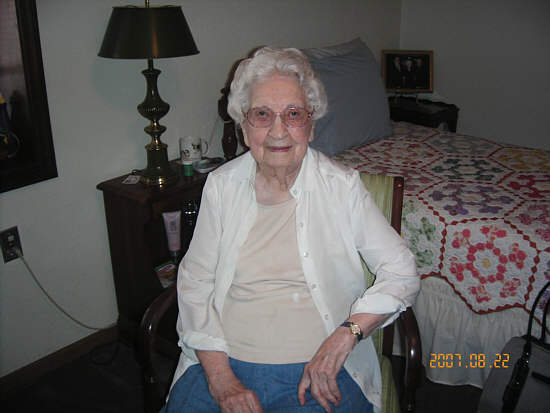 01 Helen Phillips
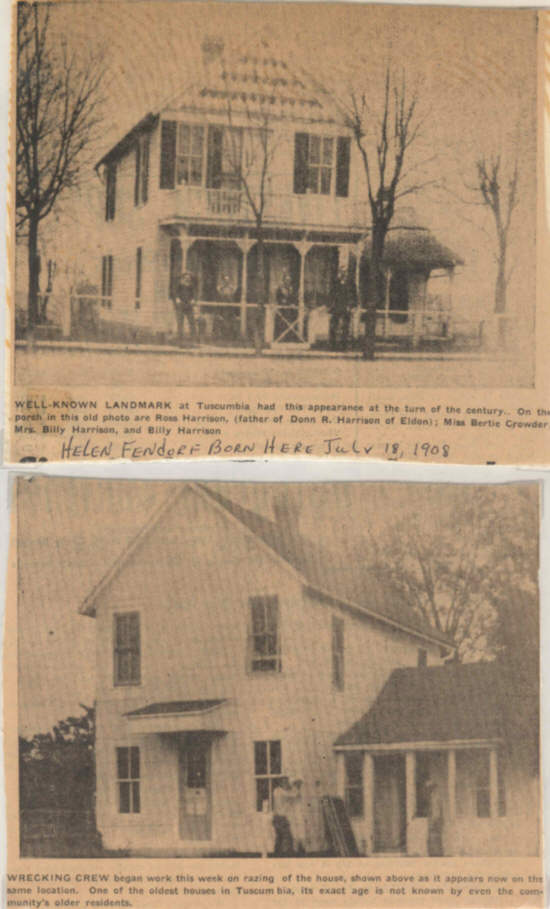 02 Harrison Fendorf T.C. Wright house
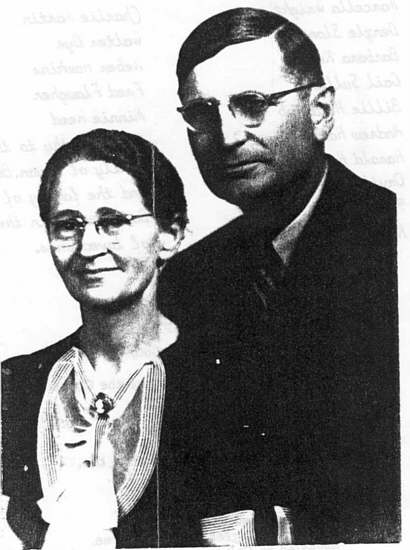 02a T.C. Wright and Mrs. T.C. Wright
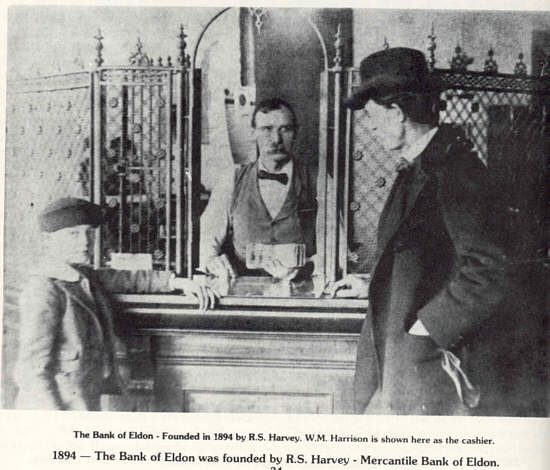 03 William Harrison
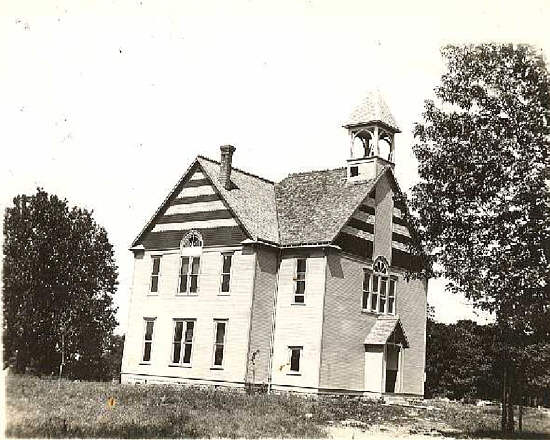 04 old school 1920
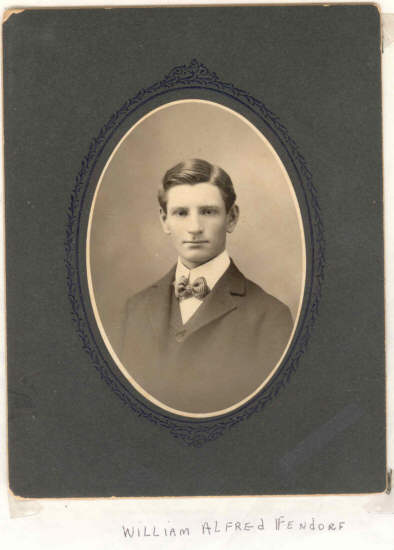 05 William Alfred Fendorf father of Helen
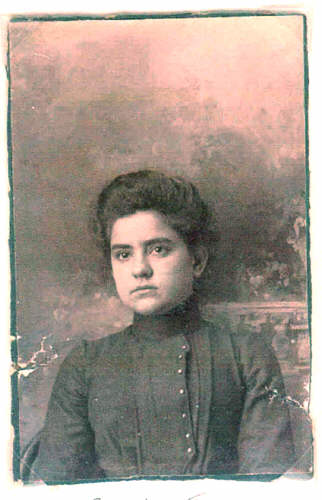 06 Rosa James Fendorf
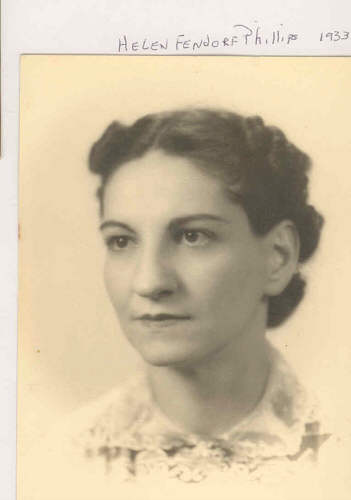 07 Helen Phillips 1933
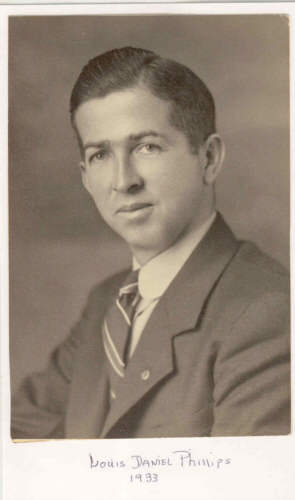 08 Louis Phillips
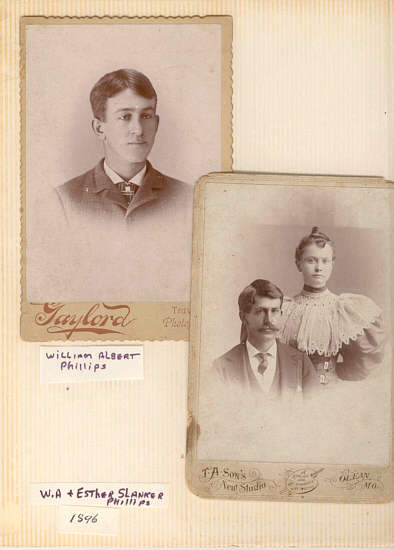 09 William Albert Phillips Jr. and wife Esther Slanker
Helen's great grandfather, Henry Fendorf, was born in Germany in 1808 in a small village near Hanover. He migrated to the U.S. with his brother John in 1841. After a short time in Pennsylvania, where he married Caroline Sophia Brammern, the couple came to Miller County, Missouri and settled on a farm in Equality Township on the Osage River a few miles due south of Tuscumbia (photo 10 of old plot map). His neighbors at the time were John Bear, Mrs. F. Vanatta, Lizzie Johnson, D.F. Goodrich, and David Helton. Helen's grandfather, Francis (Frank) Wilhelm Fendorf came with the family from Pennsylvania and married Mary Isabelle Martin of near Ulman, Mo. They had eight children including William Alfred (Fred), father of Helen; Lydia Caroline; Charles Ernest; Bertha May; Frank Edward; Nellie Sophia; Robert Maxwell; and Ella Mae (see family photo 11). Frank moved to Tuscumbia and built a house which is still standing today (photo 12 from the forties). He became a business man and owned and operated a large general store along the river close to Hauenstein's Store (photo 13). This photo was taken during a flood in 1916 but the fact is, the only time people took photos of downtown Tuscumbia seems to have been during a flood. However, I found another photo of the store on dry land which has a very interesting narrative by Mike Wieneman at the bottom (photo 14). Frank's son, Alfred, whom everyone then called Fred, (photo 15) went to Westminster College and began his career working in Tuscumbia at the Hauenstein's store, located just across the street from the competing store owned by his father Frank. It may seem strange these days that a son would set up in competition with his father across the street. However, things were different then and business relations were such that several stores could be located near one another selling the same types of goods. For example, my grandfather, Madison Bear, had a store (photo 16) of similar nature just down the street from Fendorf's and Haunstein's (flood photo 17) and even stranger, he rented the building in which he had the store from Ida Hauenstein, who was then the manager of Hauenstein's store after the death of her husband, George Hauenstein. A third similar type of store was on this same street facing the river called the Farmer's Exchange (photo 18 taken before it burned) located closely adjacent to and between the Bear and the Fendorf stores.
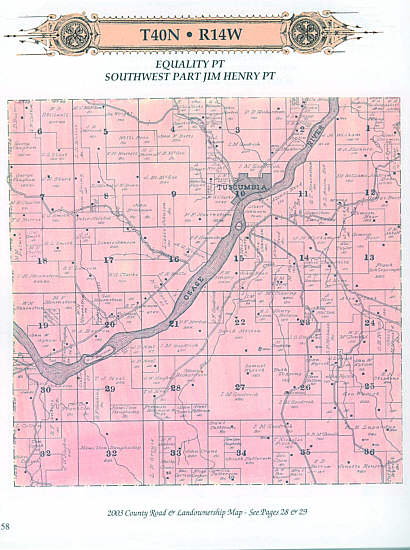 10 1905 Plot Map Fendorf Farm Section 15
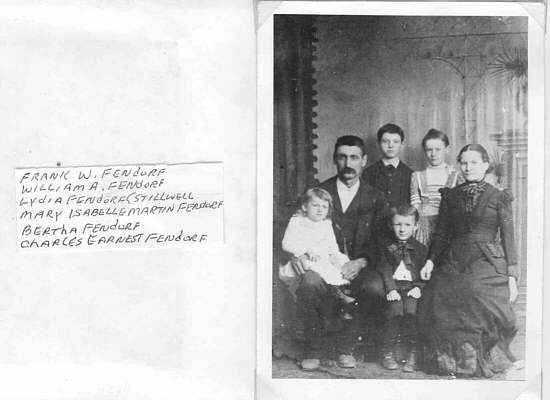 11 Fendorf Family
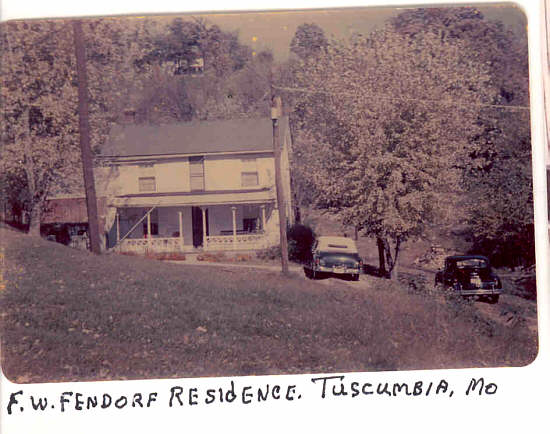 12 Fendorf residence in Tuscumbia
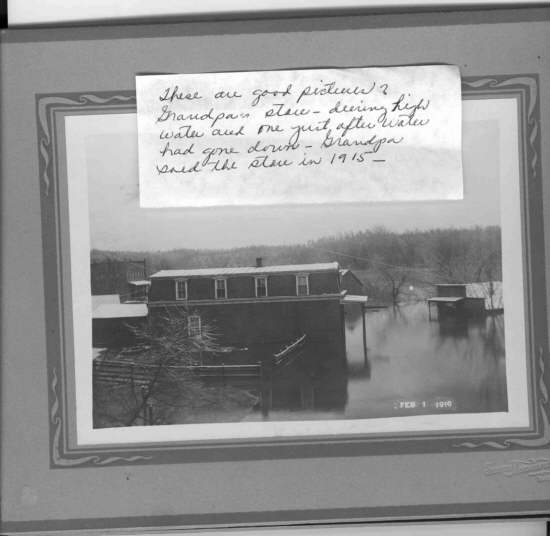 13 Fendorf Store in flood
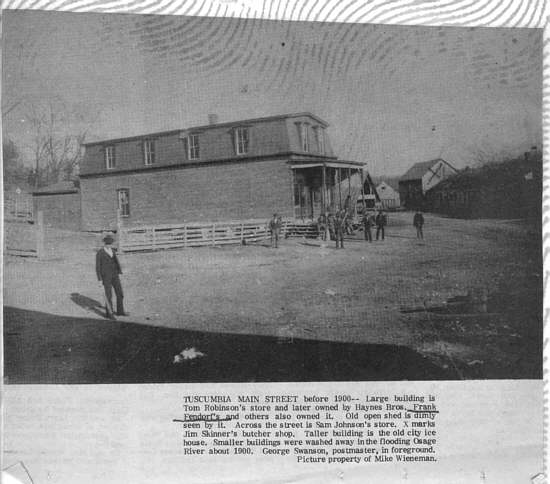 14 Goosebottom early 1900's
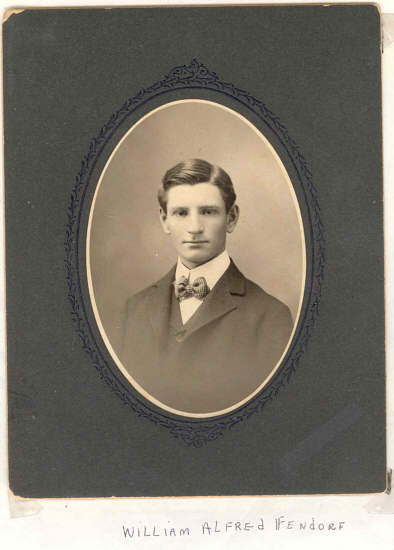 15 William Alfred Fendorf father of Helen
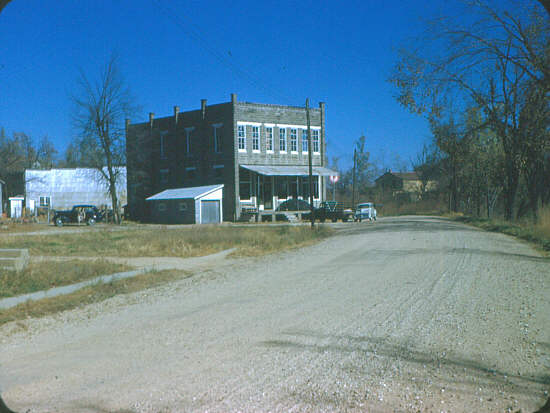 16 old Bear store, 1949 date of this photo was Sweaney's store
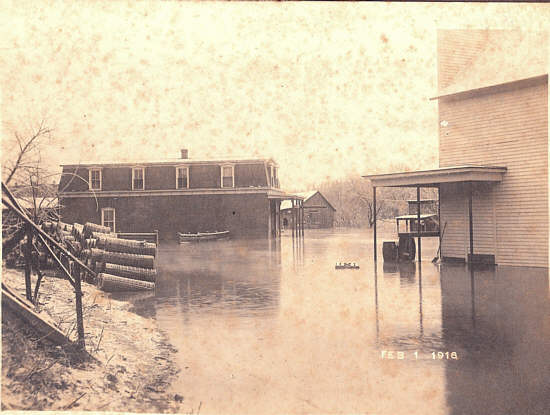 17 Fendorf store on left, Hauenstein's store on right
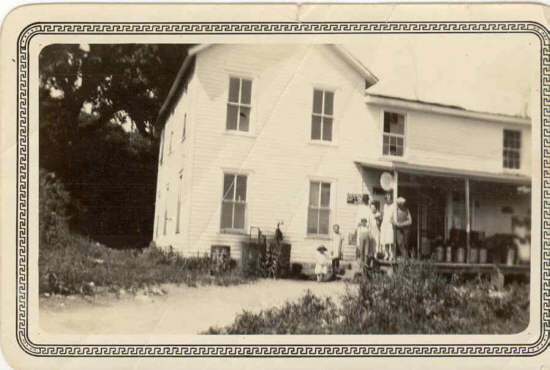 18 mfa farmer's exchange
Fred Fendorf may have wanted to work at Hauenstein's store for another reason, because the woman he married soon after, Rosa James (photo 19), was working at the store the same time. After their marriage Fred became cashier at the new Bank of Tuscumbia started by Robert Marshall, who by that time had retired from operating and managing steamboats along the Osage River (photo 20). Unfortunately, and tragically, Fred passed away from acute pneumonia in April of 1917 just three months after his father, Frank passed away. Fred and Rosa at the time had only one child, Helen, who was nine years old. Rosa and Helen stayed in Tuscumbia for a short time then Rosa decided to sell their large home on the hill to Tennyson Clay Wright and move to Eldon where Helen finished her schooling as described above.
 19 Rosa James Fendorf
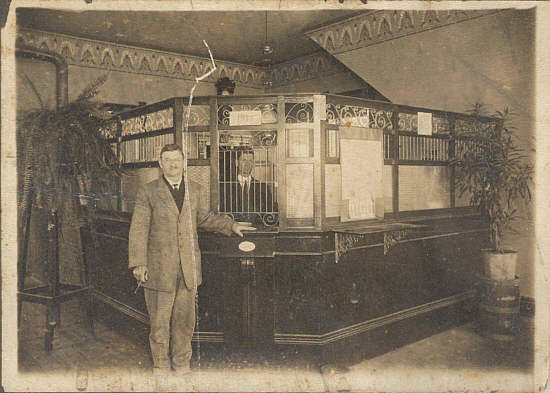 20 Robert Marshall and Fred Fendorf
Bob Fendorf, brother of Fred, became an attorney and partnered for awhile with Walter S. Stillwell, who had married his sister, Lydia. Walter and Lydia had five children: Robert, Roger, Mary, Mildred, and Marjory who died in infancy. Robert was an electrical engineer and married my mother's sister, Marie Bear, and Roger became an attorney and married Juanita Messersmith, who was the Miller County Centennial Queen . For many years, Roger owned the Abstract Office in Tuscumbia.
Ernest Fendorf married Hattie Kallenbach, daughter of Ed Kallenbach, who built the large house still standing up the hill a short distance from the Fendorf house. One of their daughters, Catherine, married Dr. Stanley Humphreys who practiced in Tuscumbia with his brother, Marshall. Ernest also was a banker in Tuscumbia.
Nellie Fendorf married Churchill Kouns, the son of Dr. Kouns, a very well known physician who practiced in Tuscumbia for many years.
Ella Fendorf married Hannis Swanson. They had two sons, Maurice and Ronald. Ronald was the basketball coach for the high school in Tuscumbia for awhile in the late fifties.
In 2005 Helen and her son Don went to the Jesse Hawken Cemetery where the Fendorf patriarch, Henry, was buried located on highway 17 one mile east of the highway 17/52 junction inTuscumbia . The cemetery no longer is in use but is of historical interest not only because the Fendorf patriarch is buried there but it also is one of the oldest cemeteries in Miller County. The first person buried there was Charles Smith (1760-1850), a soldier of the Revolutionary War. His grave was marked with special dedication services in February 1999 by the Eldon Chapter of the Daughters of the American Revolution (D.A.R.)(photo).The property now is part of the state owned Conservation Department acquisition of several thousand acres of Saline Creek Valley land. The day Helen arrived she found the tombstone of Henry had fallen (photos 21 22 23) so she and Don stood it upright again.
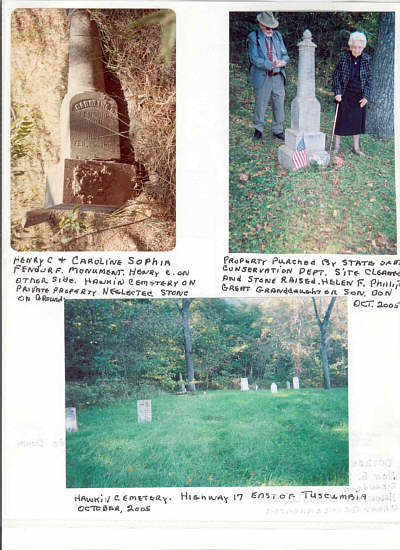 21 Hawken Cemetery Fendorf site
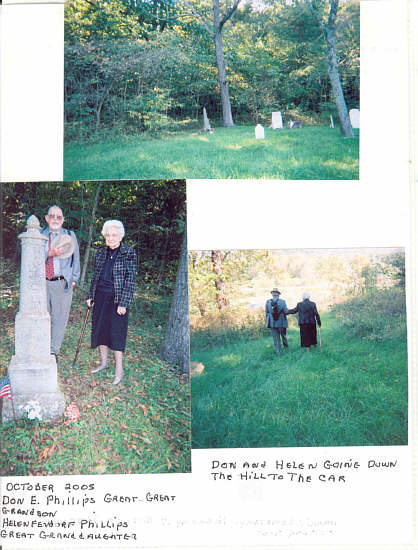 22 Hawken Cemetery
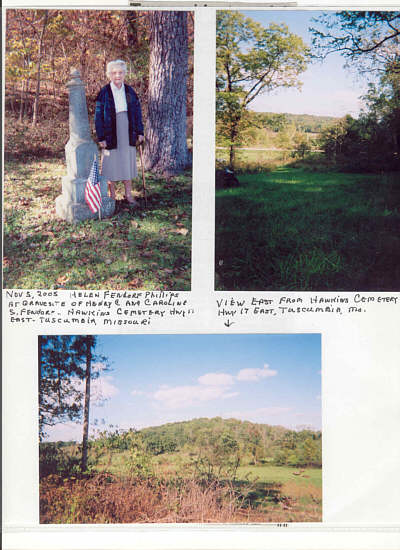 23 Hawken cemetery
We have two families in Miller County with the name Hawken/Hawkins and two cemeteries with these slightly different names. The Hawkins Cemetery is between Brumley and Ulman on Hawkins Cemetery road between highways C and 42; the Hawken Cemetery where Henry Fendorf is buried, is located as noted above just outside of Tuscumbia on highway 17. However, these cemeteries are mislabeled frequently on websites and other places including even maps where the Hawkins Cemetery road is misspelled. So I took my camara on a little trip to establish what the facts are. If you take highway 42 east out of Brumley toward Iberia a ways you will come to a road on the left where the green sign says "Hawkin Cemetery Road" (photo 24). Now this is not quite accurate, because the cemetery is actually named "Hawkins Cemetery". However, this is better than some maps which refer to the road as "Hawken Cemetery Road" which is wrong. Now proceeding North on Hawkin Cemetery Road, as the sign calls it, you will come to the Hawkins Cemetery as indicated by this sign (photo 25) on the right.
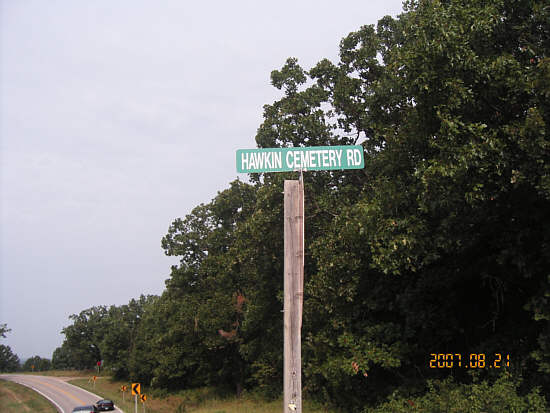 24 Hawkin Cemetery Rd sign highway 42
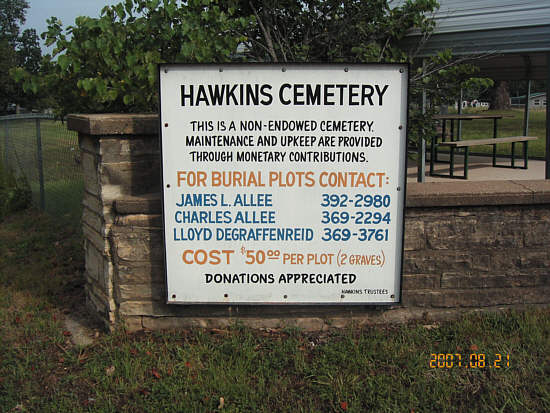 25 Hawkins Cemetery entrance
Now to get to the Hawken Cemetery continue on Hawkin Cemetery Road Northwest until you reach highway C where you turn right and continue Northeast passing through Ulman and continuing on to highway 17 where you turn left and go to Tuscumbia where you cross the Osage River bridge. After crossing the bridge turn right at the junction of highway 52 and 17 continuing to the Northeast on 17 about a mile and you will see on your left the Missouri Conservation Department sign which says "Saline Valley Conservation Area (photo 26). While making this trip from Hawkins Cemetery to Hawken cemetery you will have passed Gott Cemetery, Jackson Cemetery, and Nixdorf Cemetery all three of which are located near highway C on the right. And on highway 17 you will have passed on the right the Mt. Zion cemetery across the road from the Miller County Nursing Home.
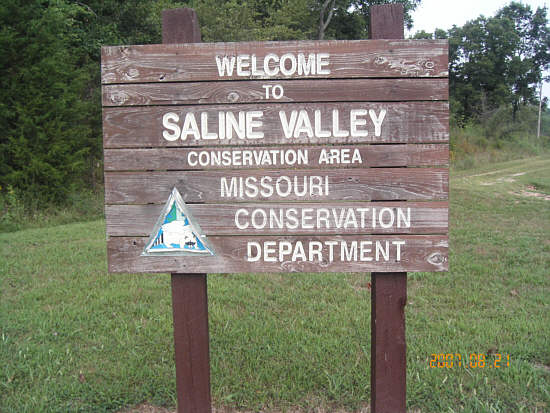 26 Conservation Dept. entrance to Hawken farm
Park your car at the Conservation Department sign because motorized vehicles are prevented from entering the area. Walk a short distance and to the left you will see a nicely mown path (photo 27) leading a short distance to the small Hawken Cemetery (photo 28). No sign indicates the name of the cemetery but over on the right side you will see the tombstone of the patriarch of the Hawken family in Miller County, David Hawken (photo 29&30). While there you can see the tombstone and honorary plaque (photo 31&32) of Charles Smith, the Revolutionary War soldier mentioned above, the tombstone of John Weitz (photo 33), another patriarch of a familiar family name around Tuscumbia and areas south, and, of course, the tombstone of Henry Fendorf (photos 34&35), the great grandfather of Helen Phillips.
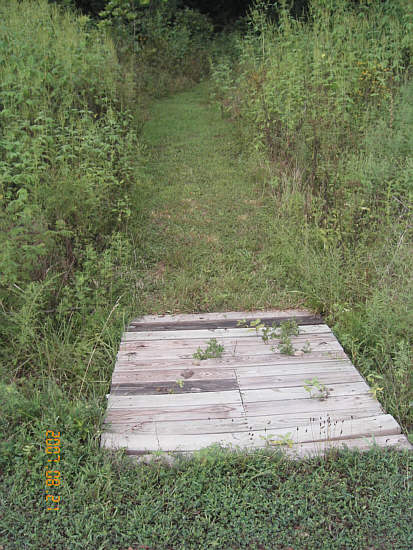 27 enrtrance to path to Hawken Cemetery
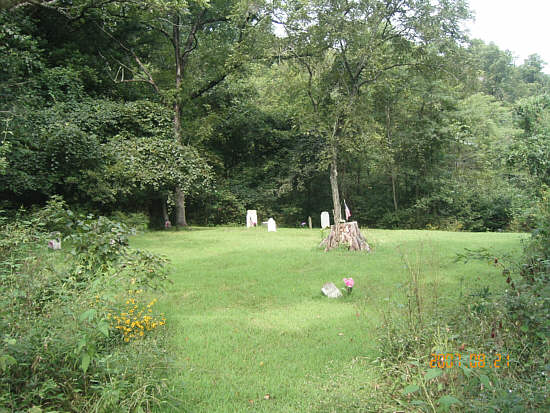 28 Hawken Cemetery
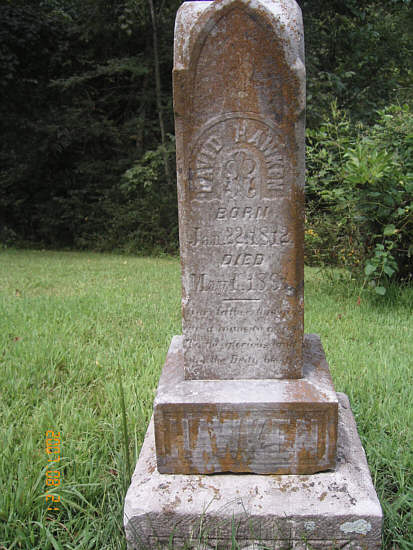 29 David Hawken tombstone
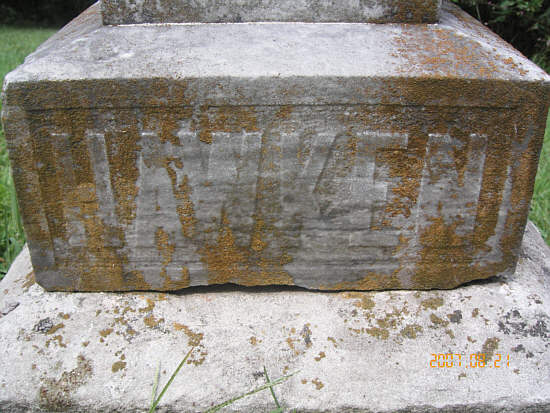 30 base of David Hawken tombstone
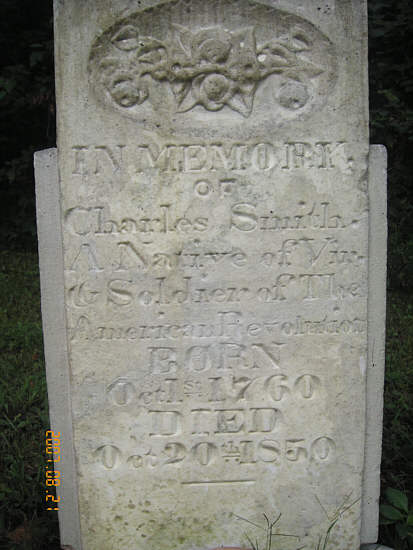 31 Charles Smith tombstone
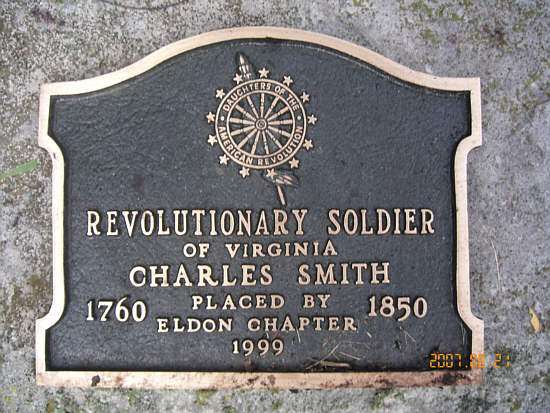 32 honorary plaque from DAR
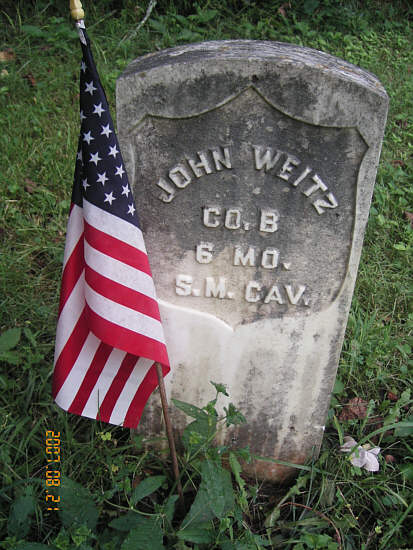 33 John Weitz tombstone
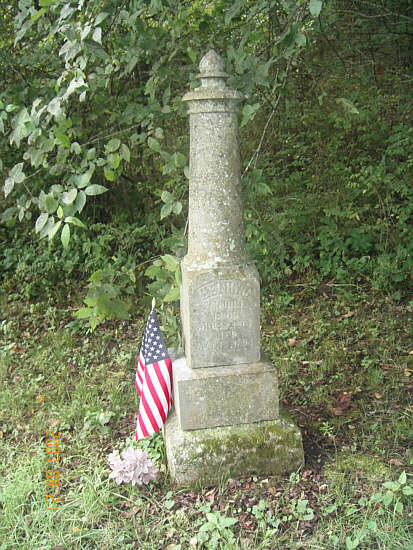 34 Henry Fendorf tombstone
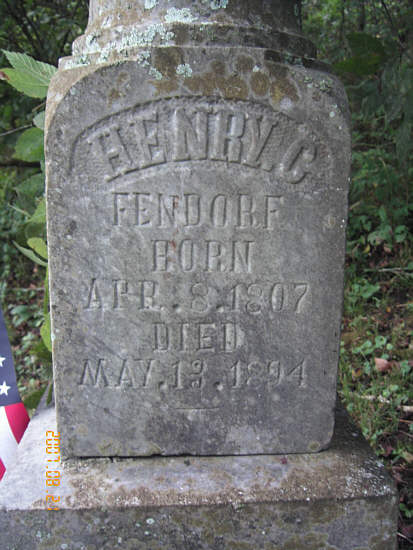 35 base of Henry Fendorf tombstone
The Hawken Cemetery is located on the Hawken family farm, now part of the Conservation Department's acquisition of thousands of acres of the Saline Valley. I talked with Jerry Hawken, a classmate of mine at Tuscumbia, and he said the original farm home which was located much further back in the valley from the cemetery is no longer standing but may have been the home that the Patriarch of the Hawken family, David Hawken, built. Sam Hawken, David's son, lived there as did David's grandson Jesse and great grandson Jerry. Jerry told me it was one of his branches of the Hawken family which invented the famous Hawken Rifle (photo 36). You can read more about David Hawken on Peggy Hake's Window to the Past section of our website found under the Publications heading at the top right of the home page.
I first became aware of the two Hawkins/Hawken spelling years ago when Ted Hawkins of Brumley became State Senator (photo 36a). Ted, who was a banker, was very community minded and served in the State Senate for fourteen years. His major interest was in improving the educational systems at the state and local levels. You can read more about him in the "People" section of the "Yesteryears" column at the top of our website.
 36 Hawken Rifle
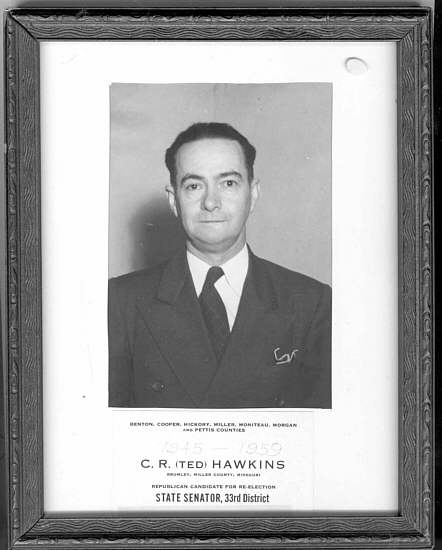 36a Senator Ted Hawkins
Continuing the conversation between Arthur and David Bear (photo 37) recorded in 1992, the brothers discuss the various food products grown on the family farms long ago and how they were used and stored.
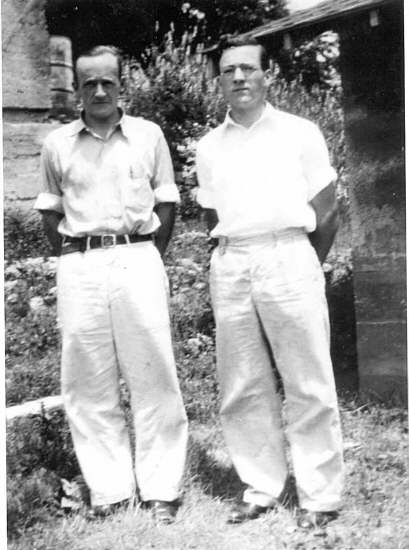 37 Arthur and David Bear
David: Here we are again to continue our conversation about
the early days of our lives. We have just been talking about
hog-killing time and the good food that came from that. I'd
like to say at this point that farm people worked very hard.
They worked off a lot of calories. and they needed a diet high
in calories and protein. To get the high calories needed for
hard work. the diet was heavy on fat products. In addition
to pork. chickens played an important role in our diet. Fryers
in the summer season and older chickens at other times of the
year. Chickens were used in egg production for eating at home
and for trading for other products. The farmers had very little
cash. so some of the products they grew did provide a little
cash. such as corn. wheat. eggs and cream. The money that came
from this was used for things the farm didn't produce and for
things they ran out of during the year. Wild game was plentiful
at one time. Also an occasional beef was slaughtered. but beef
didn't cure up like pork. so without refrigeration. it had to
be eaten quickly and some of it given to neighbors. If I
remember correctly. I was about five years old when I had my
first taste of beef. and that was at a Tuscumbia picnic held
on Wiley Berry's farm about 1922. Eating was a year-round
activity and growing farm produce occurred only during the
growing season: therefore. much had to be stored in various
ways. We stored a lot of foods such as root crops. etc. Every farm
had a fruit cellar. or a hole dug in the ground and covered
with straw. Grains like wheat and corn were taken to the mill
in Tuscumbia and exchanged for flour and meal without any use
of money. I don't recall that we ever used oats in this way.
It was usually fed to livestock. So. we had a great reliance
upon grains for food. Arthur, what else did we store away for
the winter?
Arthur: Apples. potatoes. sweet potatoes. and turnips.
David: These were often put in a hole scooped out of the ground
with straw and dirt put over the produce which kept these items
from freezing. Even on the coldest day of the year. it was
easy to get access to it. A big snow could present a problem.
Some people had a more permanent storage place known as a fruit
cellar. This was constructed by digging a hole in the ground
five-to-six feet deep and shoring up the walls and roof with
timbers. Dirt was then used to cover the roof. This fruit cellar was also used to store canned fruit. The cellar was large enough to walk into. so it was sometimes used to seek
refuge during a severe windstorm. Then it became known as the
"fraid hole." We planted a lot of beans in sufficient
quantities to hull and dry for year round use. Arthur. you
remember how we did all these things better than I.
Arthur: Yeah. in addition to what we would grow in the garden
for the table, we would plant a lot of beans in the corn field
to vine up the corn stalks. These we would let mature, and
when dry, would hull them.
David: So, beans were a big item in the diet, and is still
one of my favorite foods. Often a farmer would run out of this
delicious commodity, and then would have to turn loose of some
cash to buy more Sometimes it could be purchased in 100 pound
bags for $5.00. We also had a small orchard on our farm, didn't
we, Arthur?
Arthur: Yeah, we had an apple orchard and one or two plum trees.
David: Peaches were also available. These fruits could be
dried as well as canned. Mom would cut up the fruit in halves
or quarters and lay them out in the attic to dry. The dried
fruit could then be kept without spoilage. During the late
fall there were usually a lot of nuts to be gathered, especially
hickory nuts and walnuts. These were used in cooking. Wild
honey and bee hives provided another welcome change in our fare
of sweets. Wild honey was obtained from cutting down a hollow
tree that had been inhabited by a swarm of bees. Melons and
pumpkins were also a part of the fare. These were grown on
the family farm since there was always a shortage of cash to
buy them. Most of the food items purchased were things like
condiments: pepper, salt, and sugar occasionally. Coffee
was very important for most families. Some items of clothing
were purchased, but the housewife usually made all the female
adornments. Shoes and overalls were nearly always purchased.
We had sheep on the farm. so raw wool was taken to a carder
who would wash it and spin it into yarn. Arthur, is there
anything else that you would like to say about the self-
sufficiency of the family farm?
Arthur: I don't think of anything right now.
The following is an announcement that event planner Sharon Cogdill has sent to local newspapers this week:
General Museum Announcement
The museum will close for the season on September 1st but is getting prepared to open for visitors the following Saturday at the first fall event on September 8th which is a Classic Car exhibit sponsored by the Mid-Missouri Old Car Club.
Classic car owners will park their cars at the museum for showing
during a barbecue and country music fundraiser for our building fund. The event will start at noon and food will be served until 4:00PM.
Donations (Adults $5 and children under 6, $2:00) would be appreciated and will go into the matching building fund
program. All classic car owners are asked to come show their cars
and help with the fundraiser.
Car drivers may have a free meal in appreciation for their effort.
For more information call Jack Lupardus 498-3811 or Sharon Cogdill 365-4323.
So come out to the museum Saturday September 8 for the Classic Car event and music provided by Clifford Hill, Joe Jeffries and others. The Blue Cadillac convertible (photo 38) owned by Jack Lupardus is alone worth the trip to Tuscumbia to see.
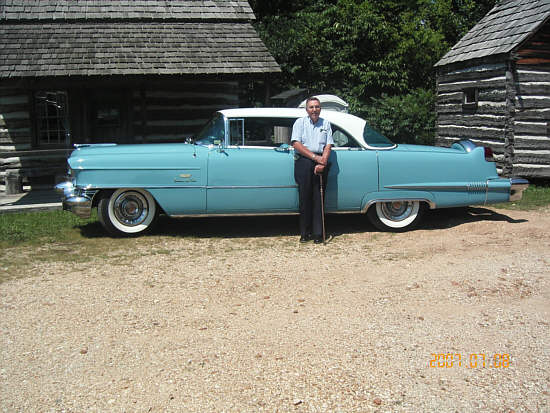 38 Jack Lupardus,Classic Cadillac
Work on the museum addition continues this week. The dry wall taping (photo 39) has been completed as has the roofing. You will notice in the photo of the man taping (Dwayne Wiggins) that we have purposefully exposed the old stone wall in two large framed windows of the east side of the old museum building. We think this adds an interesting contrast to the wall as a decorating feature. Dwayne's partner is Stormy Bell. Stormy is a Tuscumbia graduate 1977. The work has been hot inside the building. The next photo is of both Stormy and Dwayne taking a break from the heat (photo 39a)
 39 taping roof
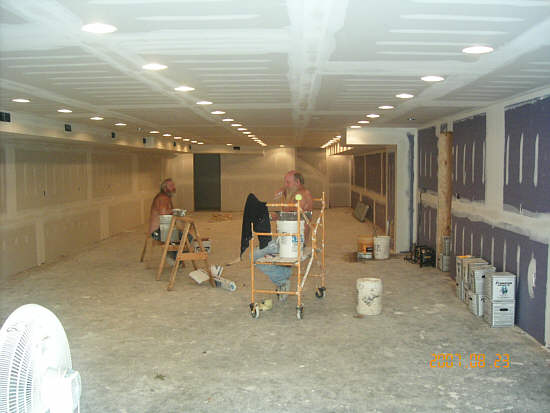 39a Stormy Bell and Dwayne Wiggins
In the right hand of Dwayne you can see he is holding a tool (the lighting was such that the photo is somewhat blurred). This tool could be our "what is it" for this week. It is called a "bazooka" for reasons which escape me. However, my brother in law, Al Cates, came up from Arkansas (he is the one whose grandmother is buried in Curry Cemetery about which I wrote a couple of weeks ago) and ended up in California in the fifties doing dry wall. He was one of the first to get one of these "bazookas" and he told me that he could do the work of three or four tapers with that odd looking mechanical device. It took a while to learn how to use it, he said, but he was in demand by builders all over Southern California for a couple of years until the other tapers got themselves one and learned to use it too.
We want to thank the group of retired School of the Osage teachers who met at the museum this week to wash the lamps in the antique lamp display. In the photo (photo 40) are pictured left to right Barbarba Riley, Naomi Campbell, and Norma Higby. Sharon Cogdill, who also is a retired Osage teacher, was not photographed because she was taking the picture.
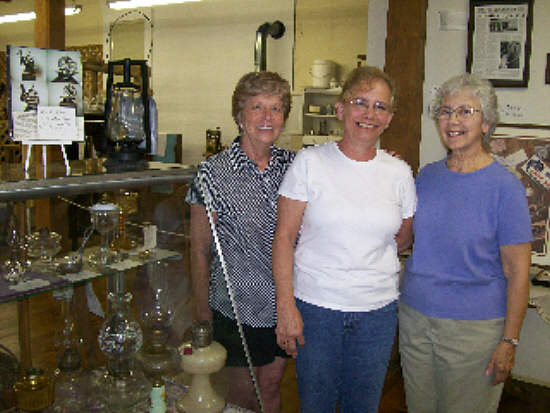 40 Barbara Riley,Naomi Campbell,Norma Nigby
You may have read the Progress Notes of the week of August 5 in which I discussed the Missouri State Penitentiary and our Miller County native Donald Wyrick who had the longest tenure of warden in the history of the prison. In that narrative I mentioned that one of the most famous prisoners of the Missouri State Penitentiary was Pretty Boy Floyd, who was incarcerated there in the late 1920's. I reported that for years I had heard that Pretty Boy Floyd hid out in Miller County at times. Well, I found some support for those rumors the other day when I came across an old weekly column in the Autogram written by Charlotte Beard in the mid 1970's. Charlotte no longer is with us but she wrote the Wildcat Creek column for quite a few years. I will let you read it for yourselves (photo 41).
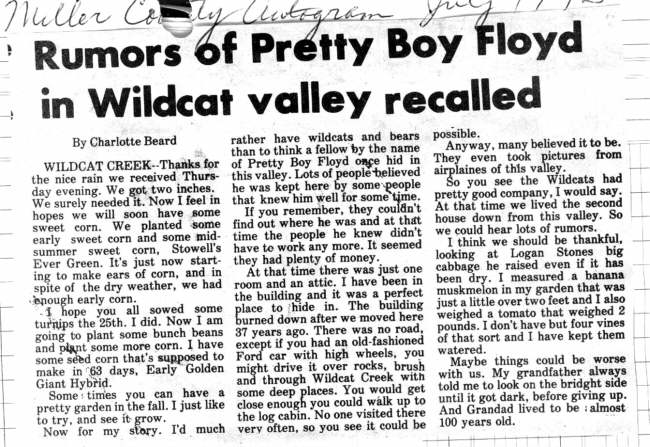 41 Pretty Boy Floyd
Our fundraising drive continues. I will be interviewed on KRMS Tuesday August 28 at 4:30 p.m. to discuss on the air our new addition to the museum. I would like to encourage all who have an interest in the preservation of the history of our culture and ancestors to consider supporting our effort to improve the museum. All donations are appreciated no matter how small you think they might be. Our address for the building program fund is:
Miller County Museum Fund Drive
P.O. Box 57
Tuscumbia, Mo. 65082
That's all for now.
| 


